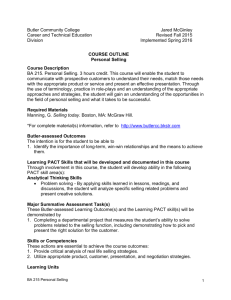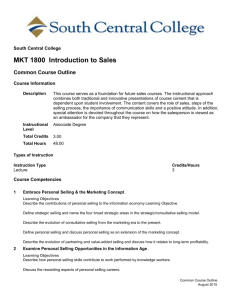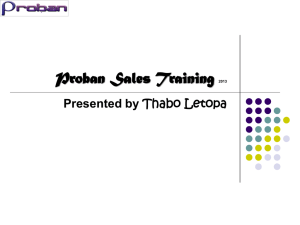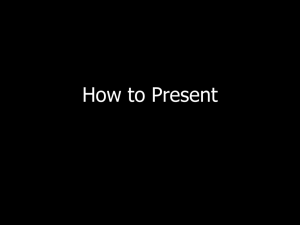Module 6
advertisement
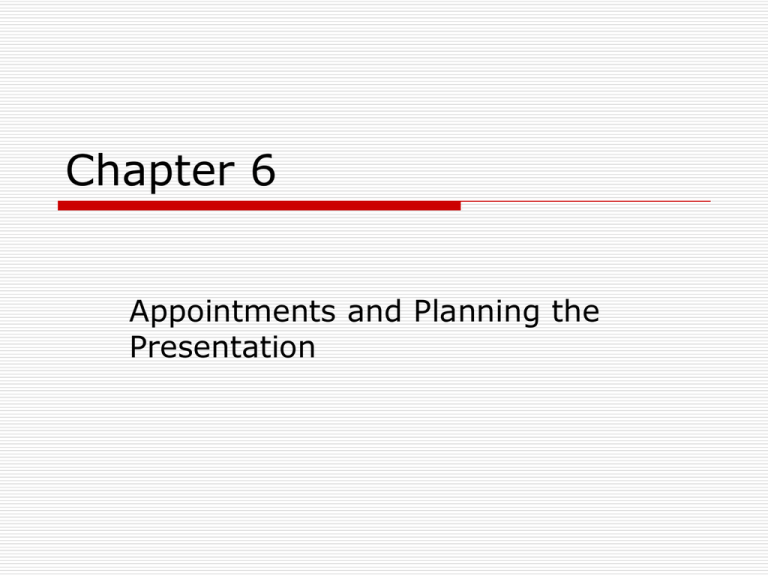
Chapter 6 Appointments and Planning the Presentation Customer-Focused Sales Dialogue Customer-Focused Sales Dialogue Sales Calls Need Discovery Sales Presentations Throughout the process, the selling strategy must focus on customer needs and how the customer defines value. Follow-Up; Build More Value Sales dialogue occurs over time and includes sales calls and other forms of buyer-seller communication. Linking Solutions to Needs Salespeople should strive to communicate to the buyer . . . How the buyer’s needs will be met or how an opportunity can be realized as a result of a purchase. How the product/service features translate, in a functional sense, into benefits for the buyer. Why the buyer should purchase from the salesperson as opposed to a competitive salesperson. If you talk with your prospect about the things that concern him/her, you’ll always have an attentive listener Getting the Appointment Experienced sales representatives try to schedule appointments in advance Appointments are efficient Appointments allow customers to see salespeople at their convenience, and to prepare for such meetings if necessary Important Pre-Approach Information (from previous chapter(s)) Examples include: Client name and pronunciation Risk/type of buying situation Communication style/profile of the buyer (may not be able to assess till several visits) What is the market position of the company Major competitor(s) of the company Industry condition/intelligence Challenges the organization may be facing Company characteristics – size, division, decision makers, etc. Setting the Appointment Most commonly used methods: Telephone In-person calls Letters Email Third party introductions What are the Strengths and weaknesses of each method? Third Party Referral Third party referral is an extension of the referral technique of prospecting The satisfied customer may be asked not only to supply names of prospects but also to write a note introducing you to that prospect This technique is particularly effective in industrial (B2B) situations Types of Sales Presentations Canned Presentation Little training is required; inflexible/not customizable; difficult to build trust Organized Presentation Extensive training is required; customizable; interactive; fosters trust Written Proposal Some training is required; customizable while being written but not once delivered; may be perceived as more credible Canned Presentations Hello ___, My name is _____. I want to tell you about . . . Include Scripted sales calls Memorized presentations Automated presentations Should be tested for effectiveness Must assume buyers’ needs are the same Written Presentations The proposal is a complete self-contained sales presentation Customer may receive proposal and a followup call to explain and clarify the proposal. Thorough assessment should take place before a customized proposal is written Organized Sales Dialogues and Presentations Address individual customer and different selling situations. Allow flexibility to adapt to buyer feedback Most frequently used format for sales professionals Establishing Sales Call Objectives 1. Primary objectives (targeted outcome) 2. Minimum objectives (lowest acceptable outcome) Establishing Sales Call Objectives 3. Optimal objectives (best possible outcome) Establishing Sales Call Objectives Use “S M A R T” steps to set sales objectives: Specific: Establish a specific, major objective for the sales call. Measurable: Ensure that your major objective is measurable or quantifiable, e.g., a certain number of units or dollar sales volume. Achievable: Make sure the goals you set are realistic and achievable. Relational: Always try to develop a long-term relationship with the prospect even if the major objective on this sales call is not achieved. Why? Temporal: If you can, establish with the prospect a specific timeframe for achieving the major objective. Determining Which Selling Strategies to Use The objective of the sales call could be to: • Introduce yourself • Gather more information about the prospect’s needs • Develop a closer relationship • Win a large order Each objective requires the selection of an appropriate sales presentation strategy. Non-Product Related Approaches Self-introduction Dramatic act Non-Product Related Approaches Free gift or sample Mutual acquaintance or reference Consumer-Directed Approaches Question Consumer-Directed Approaches Survey Compliment or praise Product-Related Approaches Product demonstration Product-Related Approaches Product or Ingredient First Impressions Ask for permission to sit Never clutter the prospect’s desk without asking for permission Watch the tone of your voice Always be courteous but not overly friendly or pushy Never be presumptuous Sales Dialogue and Presentation Template (Exhibit 6.4) Section 1: Prospect Information Section 2: Customer Value Proposition Section 3: Sales Call Objective Section 4: Linking Buying Motives, Benefits, Support Information and Reinforcement Method Sales Dialogue and Presentation Template Section 5: Competitive Situation Section 6: Beginning the Sales Dialogue Section 7: Anticipate Questions and Objections Section 8: Earn Prospect Commitment Section 9: Build Value through Follow-up Action


